三年级英语上册全册教案(外研版一起).doc
三年级上册外研版英语教案5篇
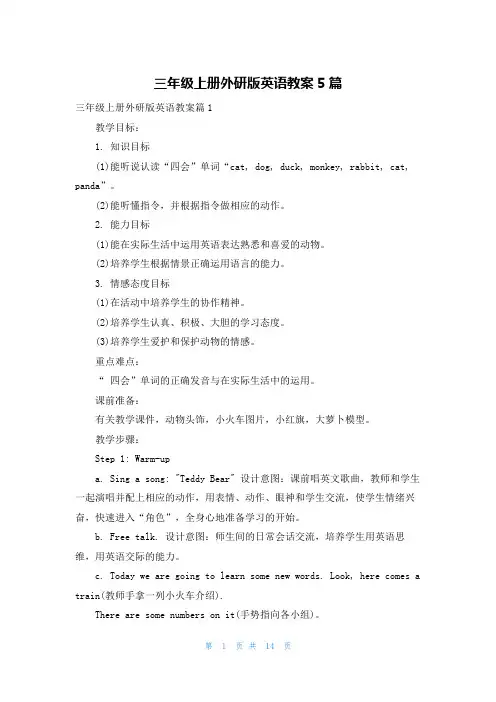
三年级上册外研版英语教案5篇三年级上册外研版英语教案篇1教学目标:1. 知识目标(1)能听说认读“四会”单词“cat, dog, duck, monkey, rabbit, cat, panda”。
(2)能听懂指令,并根据指令做相应的动作。
2. 能力目标(1)能在实际生活中运用英语表达熟悉和喜爱的动物。
(2)培养学生根据情景正确运用语言的能力。
3. 情感态度目标(1)在活动中培养学生的协作精神。
(2)培养学生认真、积极、大胆的学习态度。
(3)培养学生爱护和保护动物的情感。
重点难点:“ 四会”单词的正确发音与在实际生活中的运用。
课前准备:有关教学课件,动物头饰,小火车图片,小红旗,大萝卜模型。
教学步骤:Step 1: Warm-upa. Sing a song: "Teddy Bear" 设计意图:课前唱英文歌曲,教师和学生一起演唱并配上相应的动作,用表情、动作、眼神和学生交流,使学生情绪兴奋,快速进入“角色”,全身心地准备学习的开始。
b. Free talk. 设计意图:师生间的日常会话交流,培养学生用英语思维,用英语交际的能力。
c. Today we are going to learn some new words. Look, here comes a train(教师手拿一列小火车介绍).There are some numbers on it(手势指向各小组)。
Number 1 is for group 1; Number 2 is for group 2; Number 3 is for group 3; Number 4 is for group4.(教师拿出一面小红旗)If you do very well, you can get a red flag for your group. Let's see which group is the best. OK?(教师以手势鼓动学生回答:OK.)设计意图:小学生好胜心强,从开始就把竞争机制引入课堂,并贯穿于整堂课,大大激发了学生的学习兴趣,有利于学生完全投入到课堂活动中来。
外研社三年级上册英语教案(精选3篇)
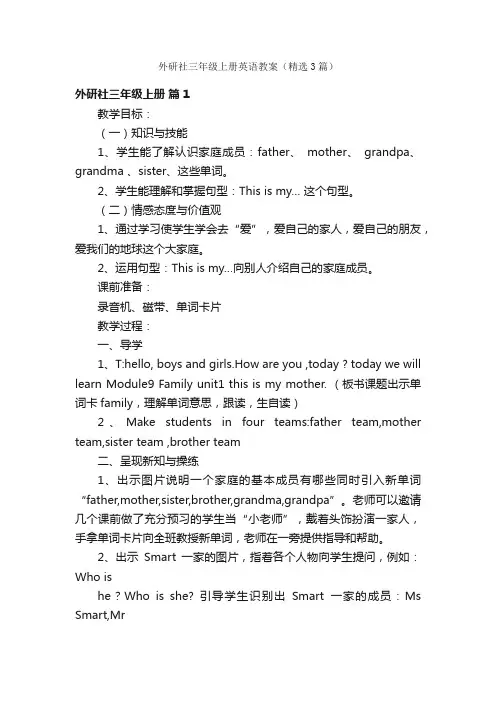
外研社三年级上册英语教案(精选3篇)外研社三年级上册篇1教学目标:(一)知识与技能1、学生能了解认识家庭成员:father、mother、grandpa、grandma 、sister、这些单词。
2、学生能理解和掌握句型:This is my… 这个句型。
(二)情感态度与价值观1、通过学习使学生学会去“爱”,爱自己的家人,爱自己的朋友,爱我们的地球这个大家庭。
2、运用句型:This is my…向别人介绍自己的家庭成员。
课前准备:录音机、磁带、单词卡片教学过程:一、导学1、T:hello, boys and girls.How are you ,today ? today we will learn Module9 Family unit1 this is my mother. (板书课题出示单词卡family,理解单词意思,跟读,生自读)2、Make students in four teams:father team,mother team,sister team ,brother team二、呈现新知与操练1、出示图片说明一个家庭的基本成员有哪些同时引入新单词“father,mother,sister,brother,grandma,grandpa”。
老师可以邀请几个课前做了充分预习的学生当“小老师”,戴着头饰扮演一家人,手拿单词卡片向全班教授新单词,老师在一旁提供指导和帮助。
2、出示Smart一家的图片,指着各个人物向学生提问,例如:Who ishe?Who is she? 引导学生识别出Smart一家的成员:Ms Smart,MrSmart,Sam,Amy和Tom.对学生说:“Sam家里还有两个成员,大家知道他们是谁吗?刚才大家看到的这些任务之间又是什么关系呢?我们一起来看一看吧!”三、自学与展示1、播放录音请学生认真听,试着理解课文的内容。
听过第一遍录音后,老师可以提出一些关于课文的具体问题,例如:“How many people are there in sam `s family?”请学生带着问题听第二遍录音后,老师可以请理解课文内容的学生内容的学生向其他同学提出问题,例如:“Who are they?”听第3遍录音时,请学生看着书跟读,画出生词,并试着找出问题的答案。
2024年三年级英语上册全册教案新版外研版
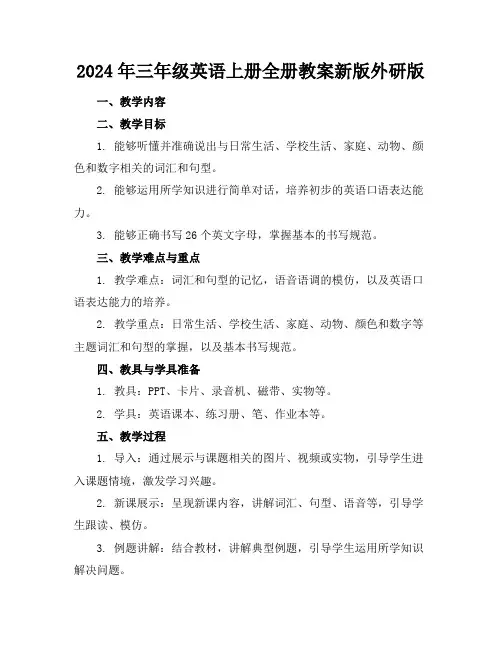
2024年三年级英语上册全册教案新版外研版一、教学内容二、教学目标1. 能够听懂并准确说出与日常生活、学校生活、家庭、动物、颜色和数字相关的词汇和句型。
2. 能够运用所学知识进行简单对话,培养初步的英语口语表达能力。
3. 能够正确书写26个英文字母,掌握基本的书写规范。
三、教学难点与重点1. 教学难点:词汇和句型的记忆,语音语调的模仿,以及英语口语表达能力的培养。
2. 教学重点:日常生活、学校生活、家庭、动物、颜色和数字等主题词汇和句型的掌握,以及基本书写规范。
四、教具与学具准备1. 教具:PPT、卡片、录音机、磁带、实物等。
2. 学具:英语课本、练习册、笔、作业本等。
五、教学过程1. 导入:通过展示与课题相关的图片、视频或实物,引导学生进入课题情境,激发学习兴趣。
2. 新课展示:呈现新课内容,讲解词汇、句型、语音等,引导学生跟读、模仿。
3. 例题讲解:结合教材,讲解典型例题,引导学生运用所学知识解决问题。
4. 随堂练习:设计形式多样的练习题,巩固所学知识,提高学生实际运用能力。
六、板书设计1. 课题:2024年三年级英语上册(外研版)2. 单元:Unit 163. 词汇、句型、语音等要点七、作业设计1. 作业题目:(1)抄写Unit 16的词汇,每个单词写5遍。
(2)根据所学句型,编写一段小对话。
(3)完成练习册上的练习题。
2. 答案:(1)见课本附录。
(2)学生自编,教师批改。
(3)见练习册答案。
八、课后反思及拓展延伸2. 拓展延伸:鼓励学生课后进行英语阅读、观看英语动画片、参加英语角等活动,提高英语实际运用能力。
同时,教师可提供相关资源,帮助学生拓展学习。
重点和难点解析1. 教学内容的针对性2. 教学目标的明确性3. 教学难点与重点的区分4. 教学过程的实践情景引入5. 板书设计的简洁明了6. 作业设计的合理性7. 课后反思及拓展延伸的实际操作一、教学内容的针对性教学内容应紧密结合教材,覆盖各单元主题,注重实用性。
三年级英语上册全册教案(外研版一起)-19
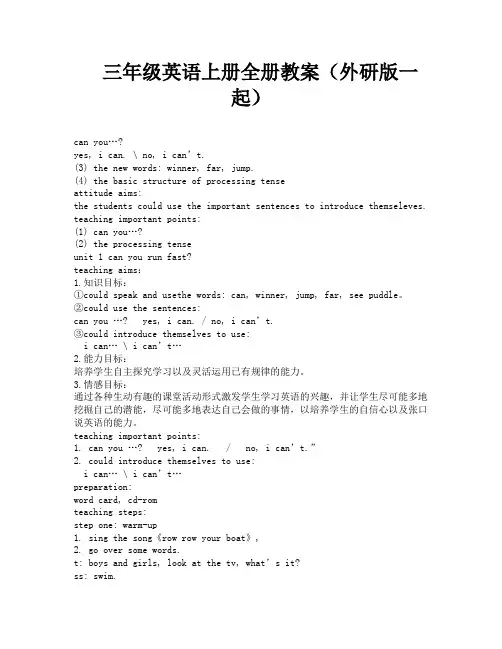
三年级英语上册全册教案(外研版一起)can you…?yes, i can. \ no, i can’t.(3) the new words: winner, far, jump.(4) the basic structure of processing tenseattitude aims:the students could use the important sentences to introduce themseleves. teaching important points:(1) can you…?(2) the processing tenseunit 1 can you run fast?teaching aims:1.知识目标:①could speak and usethe words: can, winner, jump, far, see puddle。
②could use the sentences:can you …?yes, i can. / no, i can’t.③could introduce themsel ves to use:i can… \ i can’t…2.能力目标:培养学生自主探究学习以及灵活运用已有规律的能力。
3.情感目标:通过各种生动有趣的课堂活动形式激发学生学习英语的兴趣,并让学生尽可能多地挖掘自己的潜能,尽可能多地表达自己会做的事情,以培养学生的自信心以及张口说英语的能力。
teaching important points:1. can you …? yes, i can. / no, i can’t.”2. could introduce themselves to use:i can… \ i can’t…preparation:word card, cd-romteaching steps:step one: warm-up1. sing the song《row row your boat》,2. go over some words.t: boys and girls, look at the tv, what’s it?ss: swim.t: can you swim?ss: yes. / yes, i can. /no./ no, i can’t.t: do it, please!ss: (do the action )step two: presentation1. t: today we’ll make a survey to find who can run fast/jump far and so on. now we’ll learn the unit 1.2 run & run fastt: boys and girls, can you run? put up your hands.ss: (put up their hands)t: do the action, please.ss: (do the action)t: very good. all of you can run. but can you run fast?t: all of you can run. but can you run fast?look at me , run/ run fast…t: well, can you run fast?ss: yes, i can./ no, i can’t.t: well, a, you can run fast.b, you say you can run fast.a, you come here. b, you come here.let’s see. who can run fast?3 jump & jump fart: boys and girls, can you jump?ss: yes, i can. /no, i can’t.t: who say “yes”, put up your hands.ss(put up their hands)t: well, can you jump far?ss: yes, i can. /i can’t.4. practise in pairs.(1)s1:can you run fast? (2) s1:can you run fast?s2:yes, i can. s2:no, i can’t.s1:do it, please.s2:(do the action)5. practise (sb p15)t: now, i want you to use these phrases .who can have a try?。
外研版小学三年级英语上册教案全册
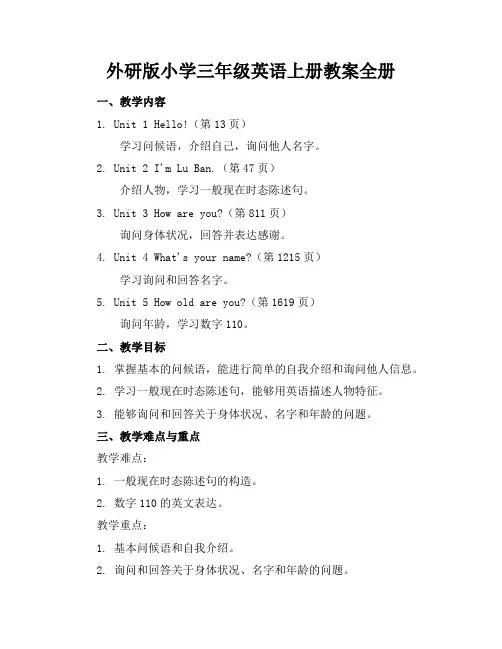
外研版小学三年级英语上册教案全册一、教学内容1. Unit 1 Hello!(第13页)学习问候语,介绍自己,询问他人名字。
2. Unit 2 I'm Lu Ban.(第47页)介绍人物,学习一般现在时态陈述句。
3. Unit 3 How are you?(第811页)询问身体状况,回答并表达感谢。
4. Unit 4 What's your name?(第1215页)学习询问和回答名字。
5. Unit 5 How old are you?(第1619页)询问年龄,学习数字110。
二、教学目标1. 掌握基本的问候语,能进行简单的自我介绍和询问他人信息。
2. 学习一般现在时态陈述句,能够用英语描述人物特征。
3. 能够询问和回答关于身体状况、名字和年龄的问题。
三、教学难点与重点教学难点:1. 一般现在时态陈述句的构造。
2. 数字110的英文表达。
教学重点:1. 基本问候语和自我介绍。
2. 询问和回答关于身体状况、名字和年龄的问题。
四、教具与学具准备1. 教具:PPT、卡片、磁铁、录音机、教材。
2. 学具:练习册、彩色笔、卡片。
五、教学过程1. 导入(5分钟)创设实践情景,如学校新生报到,播放教材录音,引导学生模仿。
2. 新课内容学习(15分钟)学习问候语、自我介绍、询问他人名字等。
介绍一般现在时态陈述句,引导学生用英语描述人物特征。
3. 例题讲解(10分钟)解析一般现在时态陈述句的结构,举例说明。
讲解数字110的英文表达,举例练习。
4. 随堂练习(10分钟)学生分组进行问候语、自我介绍、询问他人信息等练习。
学生用一般现在时态陈述句描述教室里的物品。
5. 小结与反馈(5分钟)学生展示练习成果,互相评价。
六、板书设计1. 左侧:列出本节课的重点词汇和句型。
2. 右侧:展示一般现在时态陈述句的结构。
七、作业设计1. 作业题目:每个学生准备一段自我介绍,包括姓名、年龄和身体状况。
描述自己的一位好朋友,用一般现在时态陈述句。
外研版三年级上册英语全册教案完整版
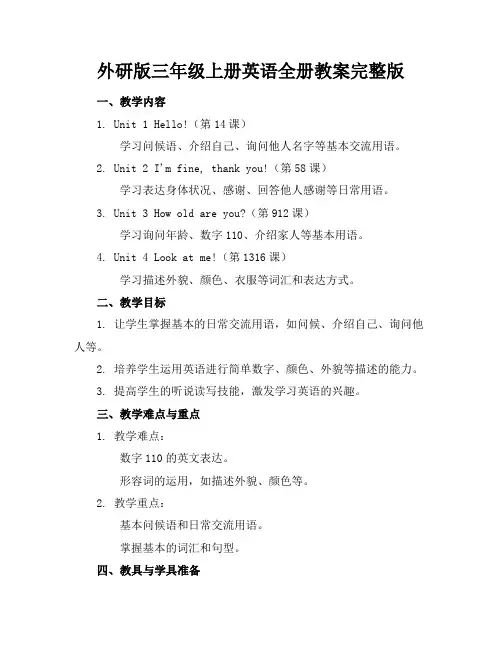
外研版三年级上册英语全册教案完整版一、教学内容1. Unit 1 Hello!(第14课)学习问候语、介绍自己、询问他人名字等基本交流用语。
2. Unit 2 I'm fine, thank you!(第58课)学习表达身体状况、感谢、回答他人感谢等日常用语。
3. Unit 3 How old are you?(第912课)学习询问年龄、数字110、介绍家人等基本用语。
4. Unit 4 Look at me!(第1316课)学习描述外貌、颜色、衣服等词汇和表达方式。
二、教学目标1. 让学生掌握基本的日常交流用语,如问候、介绍自己、询问他人等。
2. 培养学生运用英语进行简单数字、颜色、外貌等描述的能力。
3. 提高学生的听说读写技能,激发学习英语的兴趣。
三、教学难点与重点1. 教学难点:数字110的英文表达。
形容词的运用,如描述外貌、颜色等。
2. 教学重点:基本问候语和日常交流用语。
掌握基本的词汇和句型。
四、教具与学具准备1. 教具:教学光盘、磁带、PPT等辅助教学材料。
图片、卡片、挂图等视觉教具。
2. 学具:学生用书、练习册。
彩色笔、卡片等。
五、教学过程1. 导入(5分钟)播放英语歌曲,让学生跟随歌曲唱跳,营造轻松的英语氛围。
用实践情景引入话题,如问候、介绍自己等。
2. 例题讲解(10分钟)通过PPT展示例题,引导学生用英语回答。
教师讲解并示范发音、句型等。
3. 随堂练习(10分钟)分组进行角色扮演,练习所学对话。
教师巡回指导,纠正发音和语法错误。
4. 课堂小结(5分钟)5. 作业布置(5分钟)布置作业,明确作业要求和完成时间。
六、板书设计1. 外研版三年级上册英语全册教案2. 内容:各单元主题、重点词汇、句型。
例题、练习题。
七、作业设计1. 作业题目:抄写并默写各单元重点词汇和句型。
完成练习册相应练习题。
2. 答案:课后练习题答案。
八、课后反思及拓展延伸1. 反思:对教学方法、手段进行反思,为下一节课做好准备。
2024年新标准外研版小学三年级英语上册教案全册
2024年新标准外研版小学三年级英语上册教案全册一、教学内容本教案依据2024年新标准外研版小学三年级英语上册教材,共包含四个单元。
具体章节及详细内容如下:Unit 1: Hello, everyone!Section 1: Let's learnWords: hello, good morning, good afternoon, good evening, good nightSentences: Hello, everyone! Goodmorning/afternoon/evening/night!Section 2: Let's doActions: waving, greetingUnit 2: My familySection 1: Let's learnWords: father, mother, brother, sister, grandpa, grandmaSentences: This is myfather/mother/brother/sister/grandpa/grandma.Section 2: Let's doActivity: Introducing family membersUnit 3: ColoursSection 1: Let's learnWords: red, yellow, blue, green, black, whiteSentences: What colour is it? It'sred/yellow/blue/green/black/white.Section 2: Let's doActivity: Identifying coloursUnit 4: NumbersSection 1: Let's learnNumbers: 110Sentences: How many? One/two/three/fourSection 2: Let's doActivity: Counting objects二、教学目标1. 掌握基本的问候语,如:hello, goodmorning/afternoon/evening/night。
2024年外研版三年级上册英语全册教案完整版
2024年外研版三年级上册英语全册教案完整版一、教学内容Unit 1: Hello!Unit 2: I'm Liu Ming.Unit 3: This is Miss Green.Unit 4: What's your name?Unit 5: How old are you?Unit 6: My family.二、教学目标1. 掌握基本的英语问候语,能够用英语进行简单的自我介绍。
2. 学会表达年龄和家庭成员,并能够进行简单的问答。
3. 培养学生的英语听说能力,激发学生学习英语的兴趣。
三、教学难点与重点教学难点:语法结构和词汇的运用。
教学重点:口语表达能力和听力理解能力的培养。
四、教具与学具准备教具:PPT,卡片,磁带,录音机,黑板。
学具:课本,练习本,彩色笔。
五、教学过程1. 导入:通过唱英文歌曲《Hello Song》引入课题,激发学生兴趣。
2. 新课内容展示:a. 教师展示PPT,讲解教材中的对话内容。
b. 教师引导学生进行角色扮演,练习对话。
3. 例题讲解:针对每个单元的重点语法和词汇进行讲解,结合实际情景进行例题演示。
4. 随堂练习:学生完成练习册上的练习题,巩固所学知识。
5. 小组活动:分组进行对话练习,培养学生的合作意识。
六、板书设计1. 2024年外研版三年级上册英语教案2. 内容:以图表、关键词、重点句型等形式展示每个单元的重点知识。
七、作业设计1. 作业题目:a. 根据所学内容编写一段自我介绍。
b. 结合家庭实际情况,用英语介绍自己的家庭成员。
2. 答案示例:a. Hello, my name is Zhang Wei. I'm 9 years old. I have a happy family. There are four people in my family, my father, mother, sister and me.b. This is my family. My father is a doctor. My mother is a teacher. I have a younger sister. Her name is Li Na. She is 5 years old.八、课后反思及拓展延伸1. 教师反思:关注学生的学习进度,针对学生的薄弱环节进行有针对性的辅导。
外研社小学英语一起三年级上册教案[全册]
学期教学工作计本学期我的教学任务是二年级和三年级英语。
为了能更好的完成本学期的教学任务,特作计划如下:一、指导思想本学期二,三年级使用新标准教材,本教材根遵循英语学习的规律和儿童心理生理发展的需求,以小学生的生活经验和任职发展水平为基本出发点,循序渐进地设计课程,寓教于乐,寓教于学,强调学生在学习过程中的感悟、体验、实践、参与以及思维能力的发展,在良好的语言环境中融学习情感、学习能力和跨文化交际的意识的形成于语言学习的全过程,力求体现素质教育思想。
二、目标任务(一)基本情况概述1、学生情况分析本学期二,三年级的学生没有接触过英语,但学习兴趣很浓,接受能力、模仿能力很强,由于年龄的特点,注意力容易分散,学习习惯还没有养成,因此,本学期英语教学重点将放在提高学生的听读、认读等基础技能的训练与提高上,以及培养学生养成良好的倾听和阅读习惯。
因此,本学期的英语教学将面向全体学生,以激发学生学习英语的兴趣,充分调动他们的自主能动性、积极性,营造互帮互助,共同学习英语的语境。
2、教材情况分析本学期使用的新标准英语二年级上册和三年级上册是供小学二,三年级上学期使用的,全书共分10个模块,内含一个期末复习模块,每个模块分为两个单元。
一般情况下,第一单元呈现本模块所要学习的语言内容,第二单元提供若干任务型练习,包括一首儿歌和童谣。
(二)教学目标及要求a) 初步形成学习英语的兴趣和爱好,在动态真实的环境中使用英语进行简单的活动的积极性。
b)能运用英语在日常生活和课堂情景中与老师同学进行日常简单交际,如:问候他人,询问有关个人、家庭和朋友的简单信息。
c) 能运用英语参与课堂教学,游戏和其他课内外活动。
d) 能够听懂简单的指令并做出正确反应,读懂简单小故事,会唱课本上出现的英文歌和歌谣,能分角色扮演课本中的英语小故事。
(三)教学重难点本学期继续以“任务为基础”(task-based)安排教学内容,采用全身反应法(TPR),组织学生在“身体运动”和“口腔运动”中学习。
新版外研版(一起)小学英语三年级上册全册教案
新版外研版(一起)小学英语三年级上册全册教案Module 1 Unit 1: Do You Use Chopsticks in England?In this unit。
Ms。
Smart。
Amy。
and Daming go out to have fun。
On the way。
Amy gets hungry。
XXX。
because Amy is used to using a knife and fork to eat in England。
she has a hard time using XXX.XXX:Language n: XXX.Grammar Knowledge: Do you use chopsticks in England?Listening: Students can understand the words: use。
chopsticks。
hard。
people。
knife。
fork。
easy.Speaking: Students can say the words: use。
chopsticks。
hard。
people。
knife。
fork。
easy.Reading: XXX read the words in the text: use。
chopsticks。
hard。
people。
knife。
fork。
easy.Writing: Students can write the words: use。
chopsticks。
hard。
people。
knife。
fork。
easy.Language Listening: Students XXX.Skill Speaking: Students XXX related to Chinese and Western customs。
such as "Do you use chopsticks in England?" and "No。
- 1、下载文档前请自行甄别文档内容的完整性,平台不提供额外的编辑、内容补充、找答案等附加服务。
- 2、"仅部分预览"的文档,不可在线预览部分如存在完整性等问题,可反馈申请退款(可完整预览的文档不适用该条件!)。
- 3、如文档侵犯您的权益,请联系客服反馈,我们会尽快为您处理(人工客服工作时间:9:00-18:30)。
三年级英语上册全册教案(外研版一起)module 1 the general aims of module one:language points:(1) the new words: chopsticks, a knife and fork, use, easy, hard and mess(2) the basic sentence pattern and the students could make dialogues according to the sentence patterns.do you want… do you use… (3) the new words: hamburgers, chips, fast food(4) the basic structure of processing tenseattitude aims:the students could make differences in food culture between the western countries and china. teaching important points:(1) do you use chopsticks in …?do you use a knife and fork in …?(2) the processing tenseteaching difficult points:(1) the pronunciation of some new words. for example, chopsticks(2) the changes of “be”activity for module one:in module one, the topic is mainly about the different customs in china and western countries. before the class, i require the students to prepare the pictures of food. in the process of teaching, i begin the class with talking about the differences in food and then some other topics are related. with the help of pictures, the students talk about the differences in group. several minutes later, one group is given two minutes to show the results of discussion. then the teacher takes out the chopsticks and forkand knife. the students can also talk about the other aspects. this activity class is designed in the form of dicussion. the students could speak freely according to their own vocabularies.unit 1 do you use chopsticks in england?teaching aims:(1)make students remember the new words: chopsticks, a knife and fork, use, easy, hard and mess(2) mastering the basic sentence pattern and the students could make dialogues according to the sentence patterns.do you want… do you use… attitude aims:the students could make differences in food culture between the western countries and china. teaching important points:do you use chopsticks in …?do you use a knife and fork in …?teaching difficult point:the pronunciation of some new words. for example, chopstickspreparation:word card, cd-romteaching process:warming up part:the teacher shows many pictures about food.(noodles,rice, hamburgers,cakes and so on). firstly, the teacher leads the students to get familiar with these food names and then on this basis the teacher can ask them to practice the sentence pattern.do you like noodles? yes, i do.\ no, i don’t.do you want …? yes, i do.\no,i don’t.step two: presentation and practicethe teacher makes use of the picture “noodles” and a new word “chopsticks” can be leaded out.3456789101113141516171819202223242526272018--06module 1 the general aims of module one:language points:(1) the new words: chopsticks, a knife and fork, use, easy, hard and mess(2) the basic sentence pattern and the students could make dialogues according to the sentence patterns.do y ou want… do you use… (3) the new words: hamburgers, chips, fast food(4) the basic structure of processing tenseattitude aims:the students could make differences in food culture between the western countries and china. teaching important points:(1) doyo u use chopsticks in …?do you use a knife and fork in …?(2) the processing tenseteaching difficult points:(1) the pronunciation of some new words. for example, chopsticks(2) the changes of “be”activity for module one:in module one, the topic is mainly about the different customs in china and western countries. before the class, i require the students to prepare the pictures of food. in the process of teaching, i begin the class with talking about the differences in food and then some other topics are related. with the help of pictures, the students talk about the differences in group. several minutes later, one group is given two minutes to show the results of discussion. then the teacher takes out the chopsticks and forkand knife. the students can also talk about the other aspects. this activity class is designed in the form of dicussion. the students could speak freely according to their own vocabularies.unit 1 do you use chopsticks in england?teaching aims:(1)make students remember the new words: chopsticks, a knife and fork, use, easy, hard and mess(2) mastering the basic sentence pattern and the students could make dialogues according to the sentence patterns.do you want… do you use… attitude aims:the students could make differences in food culture between the western countries and china. teaching important points:do you use chopsticks in …?do you use a knife and fork in …?teaching difficult point:the pronunciation of some new words. for example, chopstickspreparation:word card, cd-romteaching process:warming up part:the teacher shows many pictures about food.(noodles,rice, hamburgers,cakes and so on). firstly, the teacher leads the students to get familiar with these food names and then on this basis the teacher can ask them to practice the sentence pattern.do you like noodles? yes, i do.\ no, i don’t.do you want …? yes, i do.\no,i don’t.step two: presentation and practicethe teacher makes use of the picture “noodles” and a new word “chopsticks” can be leaded out.3456789101113141516171819202223242526272018--06module 1 the general aims of module one:language points:(1) the new words: chopsticks, a knife and fork, use, easy, hard and mess(2) the basic sentence pattern and the students could make dialogues according to the sentence patterns.do you w ant… do you use… (3) the new words: hamburgers, chips, fast food(4) the basic structure of processing tenseattitude aims:the students could make differences in food culture between the western countries and china. teaching important points:(1) do you us e chopsticks in …?do you use a knife and fork in …?(2) the processing tenseteaching difficult points:(1) the pronunciation of some new words. for example, chopsticks(2) the changes of “be”activity for module one:in module one, the topic is mainly about the different customs in china and western countries. before the class, i require the students to prepare the pictures of food. in the process of teaching, i begin the class with talking about the differences in food and then some other topics are related. with the help of pictures, the students talk about the differences in group. several minutes later, one group is given two minutes to show the results of discussion. then the teacher takes out the chopsticks and forkand knife. the students can also talk about the other aspects. this activity class is designed in the form of dicussion. the students could speak freely according to their own vocabularies.unit 1 do you use chopsticks in england?teaching aims:(1)make students remember the new words: chopsticks, a knife and fork, use, easy, hard and mess(2) mastering the basic sentence pattern and the students could make dialogues according to the sentence patterns.do you want… do you use… attitude aims:the students could make differences in food culture between the western countries and china. teaching important points:do you use chopsticks in …?do you use a knife and fork in …?teaching difficult point:the pronunciation of some new words. for example, chopstickspreparation:word card, cd-romteaching process:warming up part:the teacher shows many pictures about food.(noodles,rice, hamburgers,cakes and so on). firstly, the teacher leads the students to get familiar with these food names and then on this basis the teacher can ask them to practice the sentence pattern.do you like noodles? yes, i do.\ no, i don’t.do you want …? yes, i do.\no,i don’t.step two: presentation and practicethe teacher makes use of the picture “noodles” and a new word “chopsticks” can be leaded out.3456789101113141516171819202223242526272018--06module 1 the general aims of module one:language points:(1) the new words: chopsticks, a knife and fork, use, easy, hard and mess(2) the basic sentence pattern and the students could make dialogues according to the sentence patterns.do you want…do you use… (3) the new words: hamburgers, chips, fast food(4) the basic structure of processing tenseattitude aims:the students could make differences in food culture between the western countries and china. teaching important points:(1) do you use ch opsticks in …?do you use a knife and fork in …?(2) the processing tenseteaching difficult points:(1) the pronunciation of some new words. for example, chopsticks(2) the changes of “be”activity for module one:in module one, the topic is mainly about the different customs in china and western countries. before the class, i require the students to prepare the pictures of food. in the process of teaching, i begin the class with talking about the differences in food and then some other topics are related. with the help of pictures, the students talk about the differences in group. several minutes later, one group is given two minutes to show the results of discussion. then the teacher takes out the chopsticks and forkand knife. the students can also talk about the other aspects. this activity class is designed in the form of dicussion. the students could speak freely according to their own vocabularies.unit 1 do you use chopsticks in england?teaching aims:(1)make students remember the new words: chopsticks, a knife and fork, use, easy, hard and mess(2) mastering the basic sentence pattern and the students could make dialogues according to the sentence patterns.do you want… do you use… attitude aims:the students could make differences in food culture between the western countries and china. teaching important points:do you use chopsticks in …?do you use a knife and fork in …?teaching difficult point:the pronunciation of some new words. for example, chopstickspreparation:word card, cd-romteaching process:warming up part:the teacher shows many pictures about food.(noodles,rice, hamburgers,cakes and so on). firstly, the teacher leads the students to get familiar with these food names and then on this basis the teacher can ask them to practice the sentence pattern.do you like noodles? yes, i do.\ no, i don’t.do you want …? yes, i do.\no,i don’t.step two: presentation and practicethe teacher makes use of the picture “noodles” and a new word “chopsticks” can be leaded out.3456789101113141516171819202223242526272018--06module 1 the general aims of module one:language points:(1) the new words: chopsticks, a knife and fork, use, easy, hard and mess(2) the basic sentence pattern and the students could make dialogues according to the sentence patterns.do you want… do you use… (3) the new words: hamburgers, chips, fast food(4) the basic structure of processing tenseattitude aims:the students could make differences in food culture between the western countries and china. teaching important points:(1) do you use chopst icks in …?do you use a knife and fork in …?(2) the processing tenseteaching difficult points:(1) the pronunciation of some new words. for example, chopsticks(2) the changes of “be”activity for module one:in module one, the topic is mainly about the different customs in china and western countries. before the class, i require the students to prepare the pictures of food. in the process of teaching, i begin the class with talking about the differences in food and then some other topics are related. with the help of pictures, the students talk about the differences in group. several minutes later, one group is given two minutes to show the results of discussion. then the teacher takes out the chopsticks and forkand knife. the students can also talk about the other aspects. this activity class is designed in the form of dicussion. the students could speak freely according to their own vocabularies.unit 1 do you use chopsticks in england?teaching aims:(1)make students remember the new words: chopsticks, a knife and fork, use, easy, hard and mess(2) mastering the basic sentence pattern and the students could make dialogues according to the sentence patterns.do you want… do you use… attitude aims:the students could make differences in food culture between the western countries and china. teaching important points:do you use chopsticks in …?do you use a knife and fork in …?teaching difficult point:the pronunciation of some new words. for example, chopstickspreparation:word card, cd-romteaching process:warming up part:the teacher shows many pictures about food.(noodles,rice, hamburgers,cakes and so on). firstly, the teacher leads the students to get familiar with these food names and then on this basis the teacher can ask them to practice the sentence pattern.do you like noodles? yes, i do.\ no, i don’t.do you want …? yes, i do.\no,i don’t.step two: presentation and practicethe teacher makes use of the picture “noodles” and a new word “chopsticks” can be leaded out.3456789101113141516171819202223242526272018--06module 1 the general aims of module one:language points:(1) the new words: chopsticks, a knife and fork, use, easy, hard and mess(2) the basic sentence pattern and the students could make dialogues according to the sentence patterns.do you want… do y ou use… (3) the new words: hamburgers, chips, fast food(4) the basic structure of processing tenseattitude aims:the students could make differences in food culture between the western countries and china. teaching important points:(1) do you use chopsticks in …?do you use a knife and fork in …?(2) the processing tenseteaching difficult points:(1) the pronunciation of some new words. for example, chopsticks(2) the changes of “be”activity for module one:in module one, the topic is mainly about the different customs in china and western countries. before the class, i require the students to prepare the pictures of food. in the process of teaching, i begin the class with talking about the differences in food and then some other topics are related. with the help of pictures, the students talk about the differences in group. several minutes later, one group is given two minutes to show the results of discussion. then the teacher takes out the chopsticks and forkthis activity class is designed in the form of dicussion. the students could speak freely according to their own vocabularies.unit 1 do you use chopsticks in england?teaching aims:(1)make students remember the new words: chopsticks, a knife and fork, use, easy, hard and mess(2) mastering the basic sentence pattern and the students could make dialogues according to the sentence patterns.do you want… do you use… attitude aims:the students could make differences in food culture between the western countries and china. teaching important points:do you use chopsticks in …?do you use a knife and fork in …?teaching difficult point:the pronunciation of some new words. for example, chopstickspreparation:word card, cd-romteaching process:warming up part:the teacher shows many pictures about food.(noodles,rice, hamburgers,cakes and so on). firstly, the teacher leads the students to get familiar with these food names and then on this basis the teacher can ask them to practice the sentence pattern.do you like noodles? yes, i do.\ no, i don’t.do you want …? yes, i do.\no,i don’t.step two: presentation and practicethe teacher makes use of the picture “noodles” and a new word “chopsticks” can be leaded out.3456789101113141516171819202223242526272018--06module 1 the general aims of module one:language points:(1) the new words: chopsticks, a knife and fork, use, easy, hard and mess(2) the basic sentence pattern and the students could make dialogues according to the sentence patterns.do you want… do you u se… (3) the new words: hamburgers, chips, fast food(4) the basic structure of processing tenseattitude aims:the students could make differences in food culture between the western countries and china. teaching important points:(1) do you use chopsticks in …?do you use a knife and fork in …?(2) the processing tenseteaching difficult points:(1) the pronunciation of some new words. for example, chopsticks(2) the changes of “be”activity for module one:in module one, the topic is mainly about the different customs in china and western countries. before the class, i require the students to prepare the pictures of food. in the process of teaching, i begin the class with talking about the differences in food and then some other topics are related. with the help of pictures, the students talk about the differences in group. several minutes later, one group is given two minutes to show the results of discussion. then the teacher takes out the chopsticks and forkthis activity class is designed in the form of dicussion. the students could speak freely according to their own vocabularies.unit 1 do you use chopsticks in england?teaching aims:(1)make students remember the new words: chopsticks, a knife and fork, use, easy, hard and mess(2) mastering the basic sentence pattern and the students could make dialogues according to the sentence patterns.do you want… do you use… attitude aims:the students could make differences in food culture between the western countries and china. teaching important points:do you use chopsticks in …?do you use a knife and fork in …?teaching difficult point:the pronunciation of some new words. for example, chopstickspreparation:word card, cd-romteaching process:warming up part:the teacher shows many pictures about food.(noodles,rice, hamburgers,cakes and so on). firstly, the teacher leads the students to get familiar with these food names and then on this basis the teacher can ask them to practice the sentence pattern.do you like noodles? yes, i do.\ no, i don’t.do you want …? yes, i do.\no,i don’t.step two: presentation and practicethe teacher makes use of the picture “noodles” and a new word “chopsticks” can be leaded out.3456789101113141516171819202223242526272018--06module 1 the general aims of module one:language points:(1) the new words: chopsticks, a knife and fork, use, easy, hard and mess(2) the basic sentence pattern and the students could make dialogues according to the sentence patterns.do you want… do you use… (3) the new words: hamburgers, chips, fast food(4) the basic structure of processing tenseattitude aims:the students could make differences in food culture between the western countries and china. teaching important points:(1) do you use chopsticks in …?do you use a knife and fork in …?(2) the processing tenseteaching difficult points:(1) the pronunciation of some new words. for example, chopsticks(2) the changes of “be”activity for module one:in module one, the topic is mainly about the different customs in china and western countries. before the class, i require the students to prepare the pictures of food. in the process of teaching, i begin the class with talking about the differences in food and then some other topics are related. with the help of pictures, the students talk about the differences in group. several minutes later, one group is given two minutes to show the results of discussion. then the teacher takes out the chopsticks and forkthis activity class is designed in the form of dicussion. the students could speak freely according to their own vocabularies.unit 1 do you use chopsticks in england?teaching aims:(1)make students remember the new words: chopsticks, a knife and fork, use, easy, hard and mess(2) mastering the basic sentence pattern and the students could make dialogues according to the sentence patterns.do you want… do you use… attitude aims:the students could make differences in food culture between the western countries and china. teaching important points:do you use chopsticks in …?do you use a knife and fork in …?teaching difficult point:the pronunciation of some new words. for example, chopstickspreparation:word card, cd-romteaching process:warming up part:the teacher shows many pictures about food.(noodles,rice, hamburgers,cakes and so on). firstly, the teacher leads the students to get familiar with these food names and then on this basis the teacher can ask them to practice the sentence pattern.do you like noodles? yes, i do.\ no, i don’t.do you want …? yes, i do.\no,i don’t.step two: presentation and practicethe teacher makes use of the picture “noodles” and a new word “chopsticks” can be leaded out.3456789101113141516171819202223242526272018--06module 1 the general aims of module one:language points:(1) the new words: chopsticks, a knife and fork, use, easy, hard and mess(2) the basic sentence pattern and the students could make dialogues according to the sentence patterns.do you want… do you use… (3) the new words: hamburgers, chips, fast food(4) the basic structure of processing tenseattitude aims:the students could make differences in food culture between the western countries and china. teaching important points:(1) do you use chopsticks in …?do you use a knife and fork in …?(2) the processing tenseteaching difficult points:(1) the pronunciation of some new words. for example, chopsticks(2) the changes of “be”activity for module one:in module one, the topic is mainly about the different customs in china and western countries. before the class, i require the students to prepare the pictures of food. in the process of teaching, i begin the class with talking about the differences in food and then some other topics are related. with the help of pictures, the students talk about the differences in group. several minutes later, one group is given two minutes to show the results of discussion. then the teacher takes out the chopsticks and forkthis activity class is designed in the form of dicussion. the students could speak freely according to their own vocabularies.unit 1 do you use chopsticks in england?teaching aims:(1)make students remember the new words: chopsticks, a knife and fork, use, easy, hard and mess(2) mastering the basic sentence pattern and the students could make dialogues according to the sentence patterns.do you want… do you use… attitude aims:the students could make differences in food culture between the western countries and china. teaching important points:do you use chopsticks in …?do you use a knife and fork in …?teaching difficult point:the pronunciation of some new words. for example, chopstickspreparation:word card, cd-romteaching process:warming up part:the teacher shows many pictures about food.(noodles,rice, hamburgers,cakes and so on). firstly, the teacher leads the students to get familiar with these food names and then on this basis the teacher can ask them to practice the sentence pattern.do you like noodles? yes, i do.\ no, i don’t.do you want …? yes, i do.\no,i don’t.step two: presentation and practicethe teacher makes use of the picture “noodles” and a new word “chopsticks” can be leaded out.3456789101113141516171819202223242526272018--06module 1 the general aims of module one:language points:(1) the new words: chopsticks, a knife and fork, use, easy, hard and mess(2) the basic sentence pattern and the students could make dialogues according to the sentence patterns.do you want… do you use… (3) the new words: hamburgers, chips, fast food(4) the basic structure of processing tenseattitude aims:the students could make differences in food culture between the western countries and china. teaching important points:(1) do you use chopsticks in …?do you use a knife and fork in …?(2) the processing tenseteaching difficult points:(1) the pronunciation of some new words. for example, chopsticks(2) the changes of “be”activity for module one:in module one, the topic is mainly about the different customs in china and western countries. before the class, i require the students to prepare the pictures of food. in the process of teaching, i begin the class with talking about the differences in food and then some other topics are related. with the help of pictures, the students talk about the differences in group. several minutes later, one group is given two minutes to show the results of discussion. then the teacher takes out the chopsticks and forkthis activity class is designed in the form of dicussion. the students could speak freely according to their own vocabularies.unit 1 do you use chopsticks in england?teaching aims:(1)make students remember the new words: chopsticks, a knife and fork, use, easy, hard and mess(2) mastering the basic sentence pattern and the students could make dialogues according to the sentence patterns.do you want… do you use… attitude aims:the students could make differences in food culture between the western countries and china. teaching important points:do you use chopsticks in …?do you use a knife and fork in …?teaching difficult point:the pronunciation of some new words. for example, chopstickspreparation:word card, cd-romteaching process:warming up part:the teacher shows many pictures about food.(noodles,rice, hamburgers,cakes and so on). firstly, the teacher leads the students to get familiar with these food names and then on this basis the teacher can ask them to practice the sentence pattern.do you like noodles? yes, i do.\ no, i don’t.do you want …? yes, i do.\no,i don’t.step two: presentation and practicethe teacher makes use of the picture “noodles” and a new word “chopsticks” can be leaded out.3456789101113141516171819202223242526272121。
